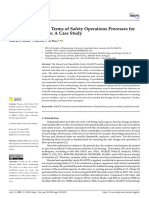Hazop Study Template
Uploaded by
Lunga Dan PatsoHazop Study Template
Uploaded by
Lunga Dan PatsoHazard & Operability Assessment (HAZOP) Process Unit: Ammonia Separation and Storage P&ID No.
Section/Node: Study Date: Property Pressure Guide Word No More of Less of Part of Deviations No Pressure More Pressure Less pressure ? Process Parameters: Pressure Consequences Causes Suggested Controls
Process Parameters: Temperature Property Temperature Guide Word No More of Less of Part of Deviations Consequences Causes Suggested Controls
Process Parameters: Flow Property Flow Guide Word No More of Less of Part of Deviations No Flow Consequences Causes Suggested Controls
Process Parameters: Level Property Level Guide Word No More of Less of Part of Deviations Consequences Causes Suggested Controls
Process Parameters: Concentration Property Concentration Guide Word No More of Less of Part of Deviations Consequences Causes Suggested Controls
Team members:
Scope of work The HAZOP study will be carried out on area 5. The HAZOP study should consider the following: 1. Initial start-up 2. Normal operation 3. Maintenance shut down 4. Emergency shut down 5. Start up after shut downs
Evaluating causes and consequences (Chevron) Causes Brainstorm all possible causes related to human factors and equipment performance Dont analyse during brainstorming Stay within section during brainstorming (Special note: feed nodes from off-plots, it is acceptable to identify causes from the node) Dont criticize during brainstorming Discuss all realistic causes in detail
o Develop Consequences Without Safeguards o Check that all consequences take system out of design envelope, i.e. outside the intended range of operation o Must identify ALL consequences (immediate and delayed both inside and outside section of analysis, injury, fire, damage, environmental or economic impact), eg compressor failure will result in shutdown of plant will eventually result in total facility shutdown o Note how consequences develop, ie how deviation will trigger alarms/ trips, etc, to trigger operator intervention Considerations: o Operator is not available or is not paying attention o Control valve are in manual o Alarm and safety interlocks do not function o Procedures are not followed or are not understood
Part of only some of the design intention achieved
You might also like
- Guidelines for Defining Process Safety Competency RequirementsFrom EverandGuidelines for Defining Process Safety Competency Requirements3/5 (1)
- MSC Computer Science With Data AnalyticsNo ratings yetMSC Computer Science With Data Analytics23 pages
- HAZOP Worksheets: Item Guide Word Deviation Possible Causes Consequences SafeguardsNo ratings yetHAZOP Worksheets: Item Guide Word Deviation Possible Causes Consequences Safeguards8 pages
- Report For Face Mask Detection Using Python and Deep Learning100% (2)Report For Face Mask Detection Using Python and Deep Learning30 pages
- Applied Sciences: HAZOP Analysis in Terms of Safety Operations Processes For Oil Production Units: A Case StudyNo ratings yetApplied Sciences: HAZOP Analysis in Terms of Safety Operations Processes For Oil Production Units: A Case Study17 pages
- Orica Engineering HAZOP Training Courses Training InformationNo ratings yetOrica Engineering HAZOP Training Courses Training Information2 pages
- Event Fault Tree Diagram R-101: Failure of ReactorNo ratings yetEvent Fault Tree Diagram R-101: Failure of Reactor9 pages
- Unclassified: Operating Limits and Conditions P-50099No ratings yetUnclassified: Operating Limits and Conditions P-5009917 pages
- Risk Assessment (HAZOP Study) Method For Decanting LPG From Dispatching Unit To Road Tanker100% (1)Risk Assessment (HAZOP Study) Method For Decanting LPG From Dispatching Unit To Road Tanker4 pages
- BBC Tech Associates: Hazop Study (NOV-2020)100% (1)BBC Tech Associates: Hazop Study (NOV-2020)37 pages
- 5 Day Course Outline of Process Safety Related TopicsNo ratings yet5 Day Course Outline of Process Safety Related Topics3 pages
- HAZOP Budgeting Tool: Practical Solutions For Today's HSE ChallengesNo ratings yetHAZOP Budgeting Tool: Practical Solutions For Today's HSE Challenges2 pages
- Introduction To Source Models: Prof. Shishir Sinha100% (1)Introduction To Source Models: Prof. Shishir Sinha47 pages
- Recognizing and Responding to Normalization of DevianceFrom EverandRecognizing and Responding to Normalization of DevianceNo ratings yet
- Comparative Analysis and Benefits of Digital Library PDFNo ratings yetComparative Analysis and Benefits of Digital Library PDF7 pages
- Sharan Galaxy Alehambra Auto Gearbox Diagram Jatco JF506E100% (1)Sharan Galaxy Alehambra Auto Gearbox Diagram Jatco JF506E5 pages
- 4.5 Detailed Syllabus of BCA 5 Semester: 1. BCS-051: Introduction To Software Engineering 3 CreditsNo ratings yet4.5 Detailed Syllabus of BCA 5 Semester: 1. BCS-051: Introduction To Software Engineering 3 Credits1 page
- Diesel Engines For Alamarin-Jet 180 - 185 Rev3-6No ratings yetDiesel Engines For Alamarin-Jet 180 - 185 Rev3-64 pages
- Engine Room Ergonomics and Machinery Layout PDFNo ratings yetEngine Room Ergonomics and Machinery Layout PDF4 pages
- ARALING PANLIPUNAN - 8 - Quarter3 - Module3 - Reb0% (1)ARALING PANLIPUNAN - 8 - Quarter3 - Module3 - Reb3 pages
- 11th Computer Science Question Bank Volume 1 Tamil Medium100% (1)11th Computer Science Question Bank Volume 1 Tamil Medium49 pages
- Honda Motorcycle 1987 OEM Parts Diagram For Right Crankcase Cover - Partzilla - Com - CopieNo ratings yetHonda Motorcycle 1987 OEM Parts Diagram For Right Crankcase Cover - Partzilla - Com - Copie7 pages
- User Guide: Dragonlink V3 Advanced Complete System Dragonlink OsdNo ratings yetUser Guide: Dragonlink V3 Advanced Complete System Dragonlink Osd71 pages
- Pilot Flame Rods - John Zink Hamworthy CombustionNo ratings yetPilot Flame Rods - John Zink Hamworthy Combustion10 pages
- Practice - 04 Working With Pages and RegionsNo ratings yetPractice - 04 Working With Pages and Regions20 pages
































































































